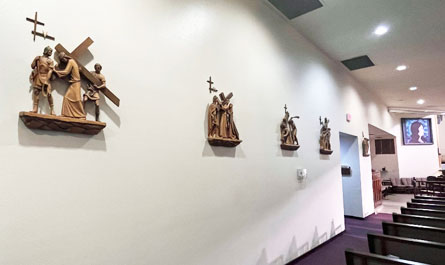By Lou Allocco
One of the oldest of Catholic traditions is the Stations of the Cross, which are a commemoration of Jesus’ last day on earth. The Stations of the Cross, also known as the Way of the Cross, or Via Delarosa (“Sorrowful Way”), allow the faithful to follow Jesus from the praetorium of Pontius Pilate to His cross on Calvary by meditating and praying along the path of His suffering and death. Each station is a “stop” along the way representing a significant event in Jesus’ Passion. The Stations are especially significant during Lent, and many churches will schedule this devotion each Friday during the Lenten season.
Catholic tradition holds that our Blessed Mother visited daily the path and scenes of her Son’s Passion. In the Fourth Century, after Constantine of the Roman Empire legalized Christianity, pilgrims would travel to Jerusalem and retrace the steps of Jesus, and the stations were marked along the pathway. This devotion continued to grow in popularity, and St. Jerome, who lived in Bethlehem during the later part of his life, attested to large groups of these pilgrims who traveled from foreign lands to follow the path of Jesus.
The use of the word “stations” for the Way of the Cross is attributed to an English pilgrim named William Wey in 1462, who described the manner in which one followed the steps of Christ. Also, around this time the modern manner of walking the path became established. Prior to this, the path was reversed, beginning at Calvary and ending at Pilate’s house.
In the fifth century there was an interest to duplicate these stations in churches in other countries to allow those faithful unable to travel physically to Jerusalem to participate in this devotion. This became increasingly important later when the Moslem Turks blocked the access to the Holy Land and suppressed this devotion there. In the 14th century, indulgences were granted to the faithful for praying at specific stations in the Holy Land, and these indulgences were later granted to those praying and meditating upon the stations in other countries.
Throughout history, the exact number and names of the stations have varied, but over time 14 stations came to be accepted. These stations are:
- Jesus is condemned to death by Pilate
- Jesus accepts His cross
- Jesus falls the first time
- Jesus meets His Blessed Mother
- Simon of Cyrene is forced to help carry Jesus’ cross
- Veronica wipes Jesus’ face
- Jesus falls the second time
- Jesus meets the women of Jerusalem
- Jesus falls the third time
- Jesus is stripped of His garments
- Jesus is nailed to the cross
- Jesus dies on the cross
- Jesus’ body is taken down from the cross
- Jesus is laid in the tomb
Many devotional books are available which describe specific prayers and meditations to be prayed while stopping at each station. Some of these books include a 15th station commemorating the Resurrection.
Most if not all Catholic churches have some form of the Stations of the Cross. These are usually placed at certain intervals along the walls, and may be represented by elaborate statues, paintings, or engravings.
The devotion of the Stations of the Cross, when done reverently through prayer and meditation, is abundant in spiritual graces and indulgences. It enables a person to deeply ponder Christ’s great sacrifice for us, and in a sense, to take up our cross and follow Him.

